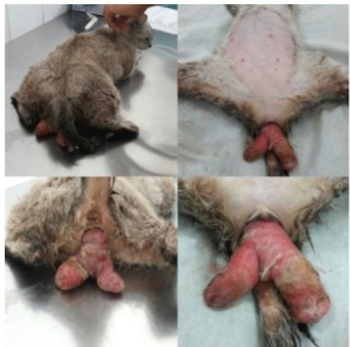Introduction
Uterine prolapse is a rare condition in small animals, occurring during or after delivery.
Objectives
The objective of this study is to describe clinical and surgical aspects of uterine prolapse in a feline.
Methods
A female feline, 1-year-old NBD, with a history of having given birth to 3 offspring and two days after bleeding and uterine prolapse, was attended at VETHOS-FUCGS. She presented dehydration (10%), pale mucous membranes and protrusion of uterus with smelly and necrotic areas. Anemia and leukocytosis were observed on the BCC. Lactated ringer solution, cephalothin (30 mg/kg IV), metronidazole (15 mg/kg IV), tramadol (3 mg/kg SC) and uterine cleaning with 0.9% NaCl were administered. The animal was referred to the hysterectomy surgical procedure. It was induced to anesthesia with propofol (3 mg/kg IV) and maintenance was achieved through 100% oxygen diluted isoflurane associated with epidural anesthesia with lidocaine 2% (0.22 mg/kg). A manual reduction of the prolapse was performed, followed by a retro-umbilical incision and opening of the cavity through the alba line, ligation of the ovarian pedicles with polyglactin-910 (2-0) and ligation of the cervix with polyglactin-910 (2-0), followed by the parker-ker suture, polyglactin-910 (2-0) and X suture, subcutaneous with polyglactin-910 (2-0) and mono nylon dermal morphology(3-0) and Wolf suture.
| Figure 1. Uterine Prolapse in a female cat | 
|
|
| |
Results
In the postoperative period, cephalexin (25 mg/kg orally) was prescribed for 10 days, meloxicam (0.1 mg/kg orally) for 3 days, tramadol (3 mg/kg orally), for 5 days and antiseptic ointment on the surgical wound.
Conclusions
After 15 days of surgery, the animal returned for reassessment and removal of the stitches and was clinically healthy.